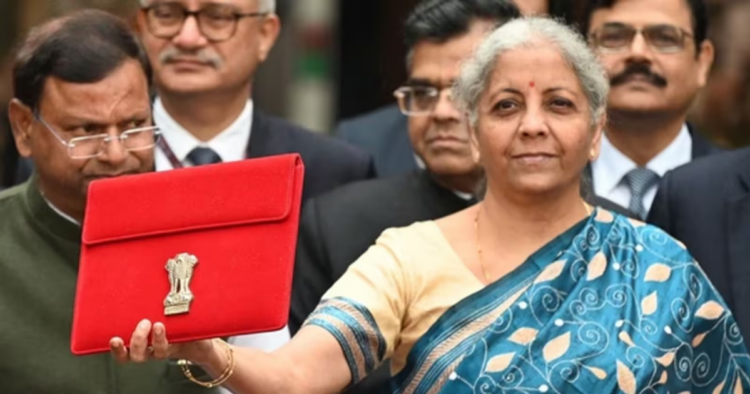The Budget 2024 has introduced significant changes in the financial landscape of India, focusing on capital and revenue expenditures, as well as tax collection dynamics. The country’s economic structure is transforming with increased capital spending and a steady rise in revenue spending.
Tax Revenue Dynamics
Income tax has now become India’s largest source of tax revenue, surpassing corporate tax. Currently, income tax, corporate tax, and the Goods and Services Tax (GST) each constitute about 30% of the total tax collection. Since the fiscal year 2019, corporate tax has experienced the slowest growth and has been quite unstable due to significant tax cuts.
In contrast, personal income tax has seen the fastest growth, while GST has shown steady progress, overtaking corporate tax since the fiscal year 2023. Among the major taxes, customs duty generates the least revenue.
Sujan Hajra, the Chief Economist and Executive Director at Anand Rathi Shares and Stock Brokers, noted that despite a significant increase in corporate earnings in the fiscal year 2024, corporate tax growth remained modest. In contrast, income tax and GST collections performed well despite low private consumption and declining inflation. For the fiscal year 2025, a slowdown is anticipated in all major tax categories except corporate tax.
Tax Collection and Economic Growth
India’s gross tax receipt buoyancy, a measure of tax revenue growth relative to GDP growth, has averaged around one over the past five years, despite major disruptions such as the pandemic and a sharp reduction in corporate tax rates. With robust GDP growth projected at around 11-12% nominally and a gross tax buoyancy of 1.2, India’s total tax collection is expected to grow at a compound annual growth rate (CAGR) of 13-15%. An 11% increase is projected for the fiscal year 2025, with a potential for substantial upside.
Non-tax revenue is also expected to rise due to higher profit transfers from the Reserve Bank of India (RBI). Transfers to states are projected to remain at about 32% of gross tax revenue.
Capital and Revenue Spending
Hajra forecasted an increase in capital spending. The ratio of revenue to capital expenditure has shifted from an average of 87%:13% between fiscal years 2014 to 2021 to 79%:21% in the fiscal year 2024. This trend is expected to continue, reaching 77%:23% in the fiscal year 2025. Capital spending growth has outpaced revenue spending growth from fiscal years 2019 to 2025.
For the fiscal year 2025, revenue spending is expected to grow by 6%, while capital spending is projected to increase by 17%, indicating an acceleration in revenue spending and a deceleration in capital spending compared to the fiscal year 2024. Spending on food subsidies and rural development is expected to rise to support rural India and boost consumption. Debt servicing costs are also likely to increase significantly.
Towards ‘Viksit Bharat’ by 2047
As India aims to achieve developed status by 2047, marking a century of independence, the nation is focusing on wide-ranging socio-economic reforms. Key aspects of this vision include an emphasis on manufacturing, particularly in emerging sectors like machine learning, artificial intelligence, and renewable energy.
The IT industry is playing a pivotal role in this transformation. Global Capability Centres (GCCs) are currently employing 1.66 million people and are expected to employ 2 million by 2026, with the number of centres rising from 1,580 to 1,900.
Recommendations for the Union Budget 2024
Srividya Kannan, Founder and CEO of Avaali Solutions, emphasized several key recommendations for the Union Budget 2024 to achieve these ambitious goals. These include enhancing export incentives, developing tier 2 locations, extending benefits for GIFT City (Gujarat International Finance Tec-City), fostering innovation, advancing skill development, revising safe harbour rules, and improving infrastructure and GST policies. Prioritising cybersecurity, hyper-scale computing, and AI will position India as a preferred destination for IT staffing and sourcing solutions.
Affordable data rates and strategic partnerships with global firms will enhance India’s appeal as an IT hub. Achieving equilibrium between input and output costs and fostering a human-centred culture are essential. The journey towards ‘Viksit Bharat’ by 2047 is both ambitious and achievable. With strategic focus and comprehensive reforms, India is poised to emerge as a global leader in various sectors, creating a prosperous future for all its citizens.
Focus on ‘Make in India’ and Ease of Doing Business
Experts have highlighted that the upcoming budget should focus on long-standing expectations of the industry, particularly the ‘Make in India’ initiative and the ease of doing business in India.
Atul Puri, Managing Partner and Co-Founder at SW mentioned that encouraging new investments and ensuring businesses are not penalised for non-compliance with the law without any malicious intent are crucial first steps. He suggested extending the time limit for starting a new manufacturing company in India to March 31, 2025, or for a further period, instead of the existing deadline of March 31, 2024, to avail the benefit of a reduced tax rate of 15% for new manufacturing companies.
Puri also recommended liberalising provisions related to prosecution for default in payment of Tax Deducted at Source (TDS). These measures would enhance the business environment, making it more conducive for growth and investment.
The Budget 2024 is poised to steer India towards substantial economic growth with increased capital and revenue spending. By focusing on tax reforms, enhancing non-tax revenue, and fostering a favourable business environment, India is set to achieve its ambitious goal of ‘Viksit Bharat’ by 2047. The emphasis on manufacturing, IT sector growth, and socio-economic reforms will pave the way for India to emerge as a global leader in various sectors, ensuring a prosperous future for all its citizens.

















Comments